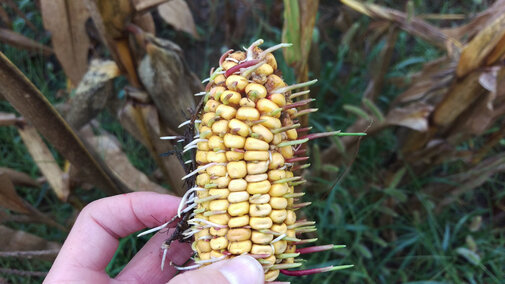Following last week's heavy rains, growers in south central Nebraska are reporting sprouting corn kernels in ears in drought-stressed and hail-damaged fields as well as in fields with upright, tight-husked ears not under stress. This kernel germination prior to harvest is called "vivipary."
Prior to full maturity it comes down to a hormonal imbalance within the kernels between gibberellin and abscisic acids (ABA). According to a study by White, et. al (2000), gibberellin production with the lack of ABA allowed for kernel germination while less gibberellin and more ABA deterred kernel germination. At full maturity, very little ABA is left in the kernel (in both corn and soybeans) which allows them to germinate in correct conditions after harvest.
These conditions include moisture and temperatures above 50ºF. Thus the continuous drizzle and rain experienced last week can allow for sprouting within soybean pods. In corn, sprouting under those conditions typically occurs at the base of the ear first but we’re also seeing it in exposed ear tips. We’ve also seen Fusarium and Gibberella ear rot fungi occurring in ears that have been damaged by hail and/or insects in ears. These fungi also produce gibberellins which can aid in the hormonal imbalance and stimulate kernel germination.
If you’re seeing kernel sprouting in your field, make sure your crop insurance adjuster is aware of the situation and submit samples for kernel damage due to mold and sprouting. Also check for mycotoxins prior to harvest if ear molds are a problem in your field. The local co-op will decide whether to accept the load based on percent damage and the standards they need to follow. If the load is rejected, contact your crop insurance agent to determine your next step.
Sprouted kernels lead to higher kernel damage and more fines in a load. Keys for harvest will include
- harvesting early,
- drying it to 14%, potentially drying at a high temperature to kill the sprout,
- screening out fines, and
- monitoring stored grain closely for hot spots, mold, and additional sprouting grain.
See these CropWatch articles by Nebraska Extension specialists for additional information on making and storing silage:
- Making Silage from Late-Season Hail-Damaged Corn by Nebraska Extension beef specialists Galen Erickson and Mary Drewnoski
- Making Silage? Protect Your Investment for the Long Term by Bruce Anderson, Nebraska Extension forage specialist


Figures 2-3. Hail-damaged corn in central Nebraska may be sprouting due to a disruption of normal growth hormones. (Photos by Jenny Rees)
Additional Information
- Field Facts: Pre-mature Germination of Corn Kernels. Du-Pont Pioneer. (2007).
- Premature Corn Kernel Sprouting (aka Vivipary). R.L. Nielsen, Corny News Network, Purdue University. (2012).
- Gibberellins and Seed Development in Maize. II. Gibberellin Synthesis Inhibition Enhances Abscisic Acid Signaling in Cultured Embryos, White et. al. Plant Physiology Vol. 122 no. 4 pg. 1089-1098. (2000).
- Wet Weather Can Cause Seeds to Sprout before Harvest. B. Wiebold. Integrated Pest and Crop Management Newsletter, University of Missouri. (2009).

